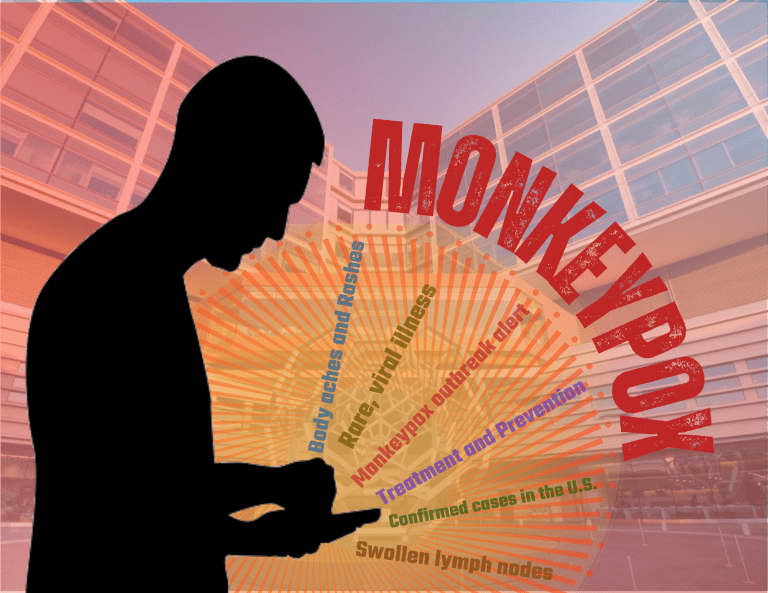As monkeypox cases begin to rise in the United States, Stanford medical experts say there is no need for panic as long as preventative measures are followed, urging the avoidance of stigma around the virus.
Headlines of monkeypox cases in the United States began to appear in early May. Though less infectious than COVID-19, the virus raised concerns within the federal government of an outbreak — but Stanford experts are cautioning against excessive alarm.
“We’re not recommending to anyone to not travel because of the risk of monkeypox,” said Jorge Salinas, director of Stanford Hospital Epidemiology/Infection Prevention and Control. “It is safe, and this infection appears to be transmitted primarily through very close, intimate contact.”
Current monkeypox infections present as painful rash-like blisters that appear across the body, particularly on the face, hands, chest and genitals, according to the Center for Disease Control and Prevention (CDC). Other symptoms of monkeypox include fever, headache and swollen lymph nodes. These symptoms commonly last 2-4 weeks until full skin recovery.
Stanley Deresinski, a clinical professor of infectious diseases, encouraged a calm and cautious approach to tackling the monkeypox community infection. The best way forward, he said, is through timely education about the development of the virus.
The first known case of the 2022 U.S. outbreak occurred on May 18, when a U.S. citizen tested positive for monkeypox on arrival back to the United States after traveling to Canada. As of July 1, the U.S. has 460 confirmed monkeypox cases, with 23 cases reported in the Bay Area.
Among U.S. states, California currently has the most cases of monkeypox with 95 confirmed cases, and New York follows close behind at 90, according to a July 1 CDC report. Deresinski expects the number of cases in the state to continue to rise, especially during peak tourism months on the West Coast.
So far, the monkeypox outbreak has primarily been seen in men who have sex with men. Given a long history of first-affected populations being scapegoated during disease outbreaks, Deresinski said he worries that the LGBTQ+ community may face heightened discrimination. Similar instances of prejudice were seen during the HIV/AIDS epidemic in the 1980s, which was labeled as a “gay disease,” and during the current COVID-19 pandemic, which has been referred to as the “China virus” or “kung-flu,” inciting racist attacks against Asian Americans.
“Even though we have not yet verified that it’s officially sexually transmitted, we know it’s associated with sexual activities,” said Ashley Styczynski, an assistant professor in the Department of Infectious Diseases and CDC medical officer. “So I think that it potentially risks carrying out some of those themes, seeing issues around stigma and ostracizing people.”
According to Salinas, the important issue is to tackle the larger issue of the virus without harmfully singling out the groups that are currently most affected.
“This [outbreak] has nothing to do with the population. It has everything to do with the virus,” he said.
For Styczynski, the CDC and news broadcasts have so far avoided creating a stigma against afflicted individuals through approachable, specific messaging toward the populations at greatest risk — providing those communities with data on the outbreak and allowing them to feel fully seen and supported in the health conversation.
“I think it is important to not do what was done with the AIDS epidemic in closing off our minds to imagine that this could affect other populations, because that would be problematic and could be a blind spot in our approach,” Styczynski said.
Salinas, who is currently collecting samples from a monkeypox-infected patient for a small-scale study on the virus, added that, “We would be making a mistake if we think that monkeypox will only be transmitted in [the LGBTQ+ community].”
He recommends continuing to follow the COVID-19 safety measures to combat monkeypox, including wearing a mask in crowded indoor spaces and practicing safe sex measures, with awareness to the infection status of sexual partners. For those who notice newly-developed bodily rashes or any other indication of monkeypox, Salinas suggests having their symptoms diagnosed to prevent further transmission.
After researching and working toward treatment for COVID-19 and monkeypox, Styczynski recognized the need to fund public health institutions and expand community resources — a gap exposed by the pandemic.
“We have to build our public health infrastructure before we’re ready to take this on in full force,” she said, underscoring the urgency of providing medical and educational resources in areas most impacted by monkeypox.
“We need to have our finger on the pulse early, we need to be paying attention,” Styczynski added. “If we pay attention before it’s a crisis, we can prevent it from becoming one. “But if we wait to care until it’s a crisis, then we will be too late.”
